Admittedly, it cost me a lot of convincing when - years ago - I attended a "big and important" auction for the first time in the midst of wine merchants, agents, collectors, enthusiasts and speculators and awaited the things to come.
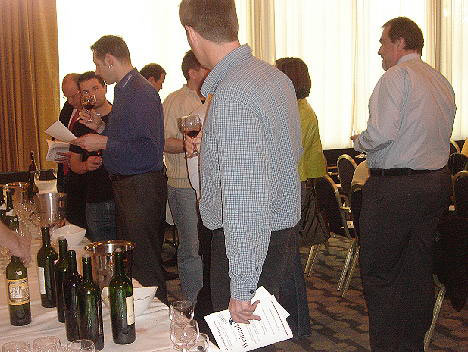 |
| Tasting and critical examination before the auction |
"An original wooden case of Château Margaux, 1996, 7,710 francs are bid, for the first - for the second - and - for the third. The lot goes to bidder 37! - To the next lot. I have to start at 3,450 francs. Who will bid more?.....", says the auctioneer. It is not easy to follow the action as a beginner, and it is even more difficult to intervene in the action without major risks and losses. Auctions have their own laws.
In the meantime, I already count myself as an experienced auctioneer. Most of the time I have the matter (and myself!) under control. A real bargain rarely escapes me. Only - there are fewer and fewer bargains and more and more bargain hunters.
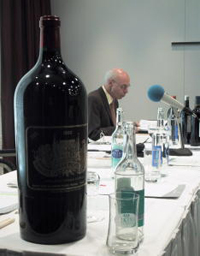 |
| The strict eye of the law is watching: the notary public. |
Most wine lovers and buyers only know auctions from the internet. There, things get hectic from time to time, especially in the last minutes and seconds. But the atmosphere is missing, that cool feverishness that always comes up as soon as a "beautiful and sought-after lot" is proclaimed. Just by the sound of the voice, the little nuances when the auctioneer calls out, you can tell that a hot, even a very hot phase is about to begin.
The frequent sensational reports that periodically accompany the worldwide auction events always nest in my head. For example: "At the British auction house Sotheby's, a bottle of 1784 Lafite was sold for 200,000 euros. Another example: "More than 9.7 million US dollars were raised at the Zachys auction house for the cellar of a single wine collector." Or: "At an auction in New York, a case of six magnum bottles of a Burgundy wine from 1985 sold for 170,375 dollars."
Thoughtfully, I then look at my narrow budget - a few hundred, maybe once up to three, four thousand francs. There's nothing to be had at Christie's or Sotheby's. Even in auctions of more modest international houses, such as Wermuth, Steinfels, Koppe and Partner, it is usually (much) more expensive.
 |
| Collection of 61 bottles of Mouton Rothschild from 1945-2003 |
Why, I ask myself, do I spend so many hours and days at auctions, why do I like going there so much?
On the one hand, it is the atmosphere that always fascinates. But above all, it is the "pulse" of the world of wine collectors and connoisseurs. This is not where prices are made, but where demand determines the prices and development of the wine world market. What becomes known only much later through the many wine publications, becomes apparent much earlier at an auction, provided one knows how to interpret the signs correctly.
The big, exciting unknown is the written bids that are already available at the start of the auction (often up to 80% of the lots). But no one in the room knows the bidding limits - except the barker. And he is silent! For the really big lots - this time, for example, for lot 792, a Mouton collection from 1945 to 2003, estimated at 35,000 to 45,000 francs - there are hardly any bids in the room. They go away anonymously, somewhere in the world.
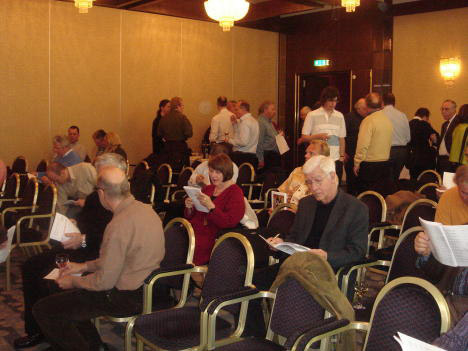 |
| Last concentration before the auction% in the hall finally 100 people |
Every now and then the auctioneer says where the journey is going: to Hong Kong, to Russia, to England, even back to Bordeaux; to a famous restaurant, to a well-known lawyer, to a yacht in the South of France... The imagination is stimulated, the rest is speculation, because the man at the table is silent about telltale details, and the notary next to him makes sure that everything is done correctly.
It is mainly the "great Bordeaux", the wine aristocracy from Burgundy and the Italian "Supertuscans" such as Solaia, Ornelleia, Sassicaia, Angelo Gaja that are traded here. This time there are 1,200 bottles of "Premier grand cru" from the Bordelais alone.
In between, many bottles and cases of almost all categories are "hiding", at handsome prices, but there are hardly any bargains (anymore). An auction lasts many hours, last time it was six and a half, with a single short break of 20 minutes. 1050 lots had to be whipped through, only 30 of them found no buyers.
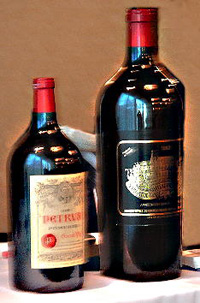 |
| Two large bottles: just a chimera? |
A lot of the wine world becomes visible here, because everyday wine life is initiated here, the preferences, the prices, the availability of wines. More decisions are made here - without talking about it - than at all the wine fairs and tastings, no matter how big. This is where the trade (including speculation) competes against what I call worldwide wine love, wine taste, wine idea. This competition for favour ultimately becomes the touchstone of how much the consumer is willing to pay for a product (which is also heavily subject to fashions).
To put this in more concrete terms: At the last auction - which I report on here - 6,800 normal bottles were offered, plus 400 magnums, 29 double magnums, 240 half bottles and 10 much larger formats (the largest an 18-litre bottle!). The turnover was 1,520,000 Swiss francs or just under one million euros. If we apply the famous average, then 190 SFr (120 ) was paid for a 7.5 dl bottle at this auction.
Just a numbers game? Far more than that! Since by far the largest part of the wines will go back into the global trade, decisive developments are in the offing here: which wines will be sold in the near future and at what price? But above all: which wines can be sold where, how do supply and demand develop?
Nevertheless, there are always a few good buys at such auctions, even in times of high prices: bargains. That is, when soiled labels, mouldy boxes, written or scratched labels make the wines "unusable" for the trade, but just as valuable for the connoisseur.
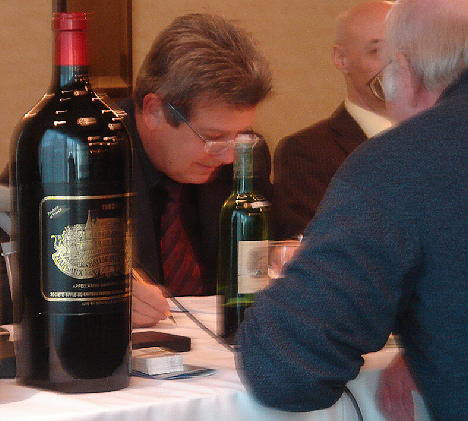 |
| One does not always agree |
So I bought - among the almost 7,000 bottles - 6 Tour de Pez 95 and 6 Haut-Caussan 94 for 15 SFr (9.50 ) a bottle. Even if there is a 20% surcharge and VAT, this is still a respectable "bargain". Or: 2 bottles of Haut-Brion 1964 estimated at 500 SFr. bought for half, while the neighbouring lot of 6 Pétrus 1989 (estimated at 16,000 SFr.) went for 24,000 SFr.
Nevertheless, for me auctions are no longer bargain hunts. They are encounters with the best wines in the world and with the people who are willing to pay a lot for them. They are "snippets of reality" from a world that has to do with business, but ultimately with enjoyment. And that's where I belong - even with the smallest budget.
Sincerely
Yours sincerely
Peter (Züllig)